
TARGET 110216
Science Leads the Way
Camp Century, Greenland
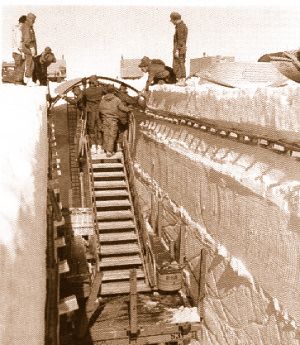
Camp Century, Greenland
Coordinates:
77° 11' N, 61° 08' W
Camp Century was a nuclear powered research center built by the US Army Corps of Engineers under the icy surface of Greenland. It was occupied from 1959 to 1966 under the auspices of the Army Polar Research and Development Center. Its climatically hostile environment was located a mere 800 miles from the North Pole. The site was chosen May 17, 1959. At 6180 feet above sea level, this flat plateau features a mean temperature of minus ten degrees Fahrenheit, recorded temperatures of minus 70 degrees and winds exceeding 125 mph. The average annual snow accumulation is four feet.
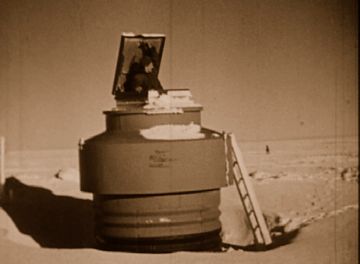
The overall project was under the command of Colonel John H. Kerkering. Captain Thomas C. Evans was the Project Officer for everything non-nuclear and Major James W. Barnett was the Resident Engineer and Nuclear Project Officer. Captain Andre G. Broumas was the inspirational commander of the first contingent to remain at Camp Century during the winter. "ANOTHER DAY IN WHICH TO EXCEL!" was his motto. Construction started June 1959 and was completed October 1960. The completed project cost $7,920,000, which included the $5,700,000 cost of the portable nuclear power plant.
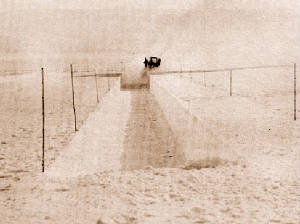
Maximum use was made of snow as a building material. Camp Century utilized a "cut-and-cover" trenching technique. Long ice trenches were created by Swiss made “Peter Plows”, which were giant rotary snow milling machines. The machine's two operators could move up to 1200 cubic yards of snow per hour. The longest of the twenty-one trenches was known as “Main Street.” It was over 1100 feet long and 26 feet wide and 28 feet high. The trenches were covered with arched corrugated steel roofs which were then buried with snow.
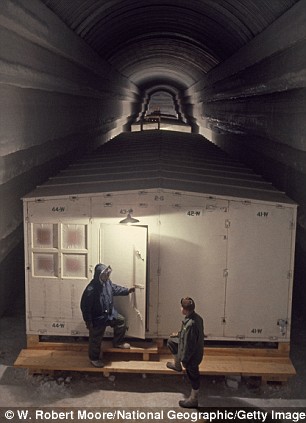
Prefabricated wood work buildings and living quarters were erected in the resulting snow tunnels. Each seventy-six foot long electrically heated barrack contained a common area and five 156 square foot rooms. Several feet of airspace was maintained around each building to minimize melting. To further reduce heat build-up, fourteen inch diameter "air wells" were dug forty feet down into the tunnel floors to introduce cooler air. Nearly constant trimming of the tunnel walls and roofs was found to be necessary to combat snow deformation.
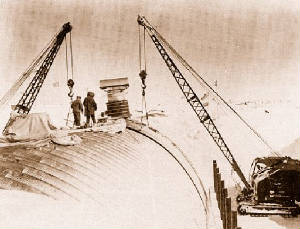
Upon completion, Camp Century was a year-round arctic research center operating under the ice. Facilities of this city beneath the ice included:
- Living quarters
- Kitchen and mess hall
- Latrines and shower
- Recreation hall and theater
- Library and hobby shops
- Dispensary, operating room, & ten bed infirmary
- Laundry
- Post Exchange
- Scientific labs
- Cold storage warehouse
- Storage tanks
- Communications center
- Equipment and maintenance shops
- Supply rooms and storage areas
- Nuclear power plant
- Standby diesel-electric power plant
- Administrative buildings
- Utility buildings
- Chapel
- Barbershop
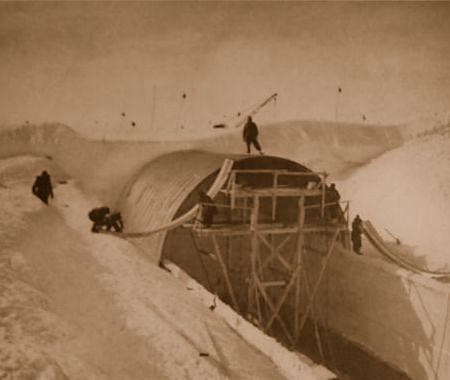
The camp was staffed year round, with population peaking at nearly 200 over the summer months. Camp Century even had a base mascot, a hearty Siberian Husky named, "Mukluk".
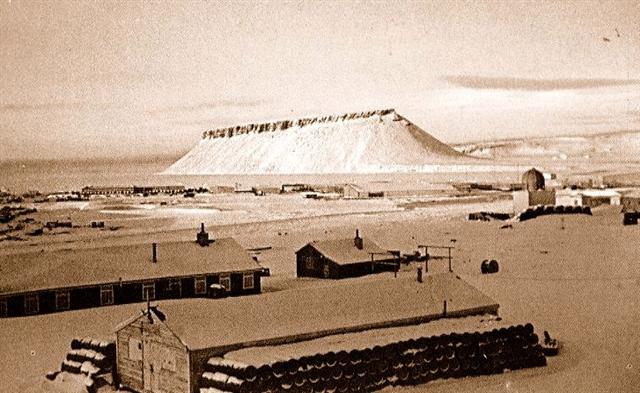
Thule Air Base, Greenland
Most of the supplies came via Thule Air Base, an arduous one hundred and fifty miles to the west. Thule Air base is the US Air Force's northernmost base.

Water Well and Equipment
The water supply was produced by pumping steam deep down into an ice well. This "Rodriguez Well" produced over 10,000 gallons of fresh water daily. This fresh water supply had fallen on Greenland as snow nearly two thousand years before.
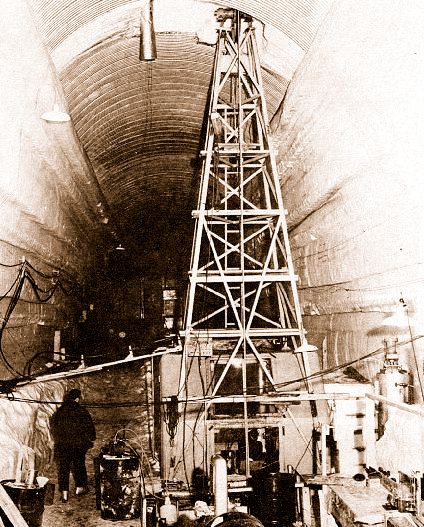
Deep ice core drilling was a major focus. Physicist B. Lyle Hansen headed the drilling effort. From a tunnel within Camp Century, the bottom of the Greenland Ice Sheet was first reached in 1961. Two initial attemps failed due to shifting ice breaking the drills. The successful 4550 foot core drilling was accomplished by utilizing a thermal drill to 1755 feet followed by an electromechanical drill. For the first time, continuous ice cores representing over 100,000 years of climatic history could be studied. It would be years later that the true value of the ice cores would be widely realized. Much has since been learned from studying the ice geology below Camp Century. The data has been revisited most recently in studies of global warming and as well as research regarding past Earth strikes by meteoroids and comets.

Other Camp Century projects focused on arctic meteorological studies and the density, hardness, strength, and permeability of snow. Camp Century was also a demonstration of how troops might live and fight under difficult arctic conditions.
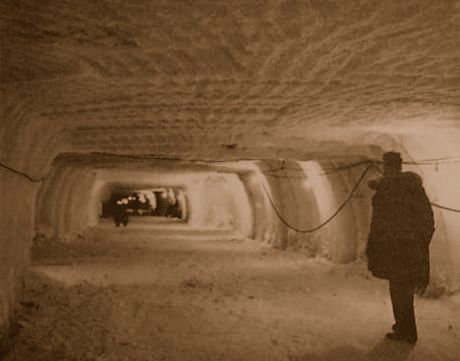
With the advent of long-range bombers and intercontinental ballistic missiles, it was inevitable that military attention would be drawn to remote but strategic arctic regions. Camp Century may have also been a pilot project for a network of proposed missile sites under the ice sheet, code named "Project Iceworm." During this period of the Cold War, the US Army was working on plans to base newly designed "Iceman" ICBM missiles in a massive network of tunnels dug into the Greenland icecap. The Iceworm plans were eventually deemed impractical and abandoned. (No missiles were ever known to have been based at Camp Century.)
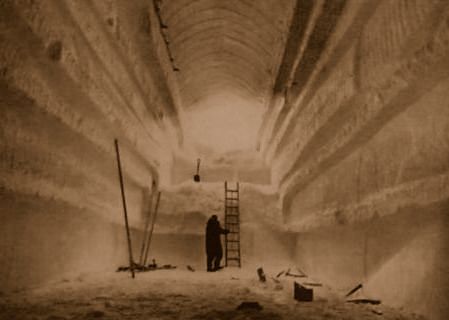
Camp Century was designed to have a useful life of at least ten years with proper maintenance. However, due to unanticipated movement of the glacial ice, it essentially became a summer camp in 1964. Maintaining the tunnels at Camp Century required time-consuming and laborious trimming and removal of more than 120 tons of snow and ice each month. Camp Century was abandoned for good in 1966. The Greenland icecap, in constant motion, would completely destroy all the tunnels over the course of several years.
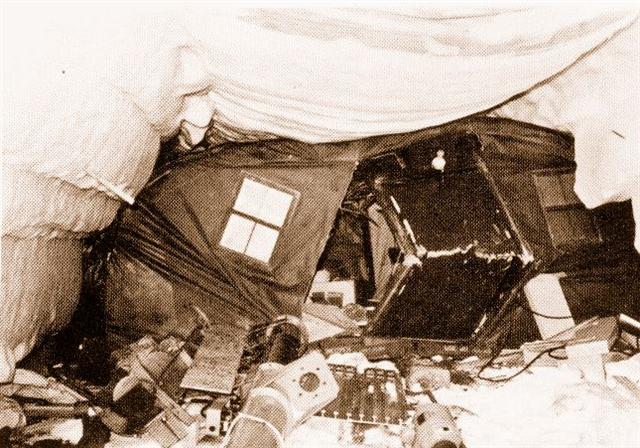
Camp Century Revisted--1969
An Army team revisited Camp Century during the summer of 1969. Severe damage to the underground city was documented at this time. Observed were buckling metal arches, torn and twisted steel beams, snapped supporting timbers, and the still furnished buildings and other equipment being slowly crushed under the extreme pressure of the encroaching snow. Today, it is likely that most of Camp Century has been reclaimed by the ice. Its twisted wreckage is a permanently frozen memorial to Man's desire to explore even the most hostile places of Earth.
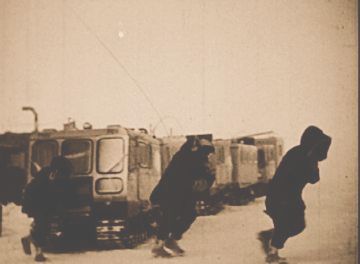

The Power Plant
The US Army Nuclear Power Program was created to develop small nuclear power reactors for use at remote sites. Most were based on existing US Naval reactor designs. Eight reactors were built in all, and six of the eight produced useful power. The nuclear reactor at Camp Century was the first of the US Army's portable reactors to actually produce power.
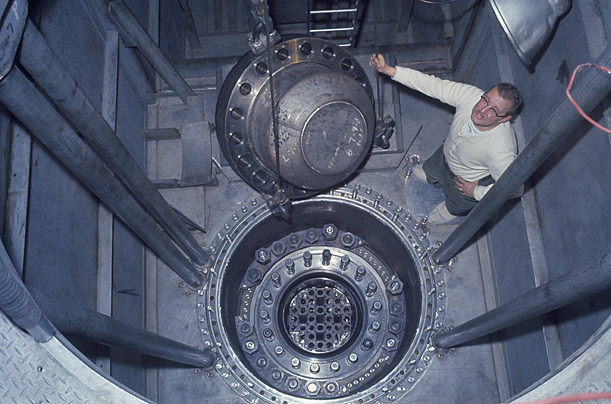
PM-2A Reactor Vessel
The portable nuclear power plant at Camp Century was designated PM-2A. Its designation indicates: “P” for Portable; “M” for Medium Power; “2” for the sequence number; and the letter “A” indicates field installation. The PM-2A was rated two megawatts for electrical power and also supplied steam to operate the water well. The PM-2A was built by Alco Products, Inc. of Schenectady, New York. The USNS Marine Fiddler transported the reactor from Buffalo, New York to Thule Air Base in Greenland, arriving on July 10, 1960. Up to this time, it was the most valuable cargo ever shipped out of the port of Buffalo.
In addition, the Army flew one of the three blast coolers to Thule on a C-124 Globemaster to demonstrate the practicality of air transport. Four hundred tons of pipes, machinery, and components were then carefully transported over the ice in twenty-seven packages. Special care was taken not to damage the parts, since intensely cold metal can become dangerously brittle. As a credit to superb packaging, a ceramic top to a lab cabinet was the only item damaged during transport.
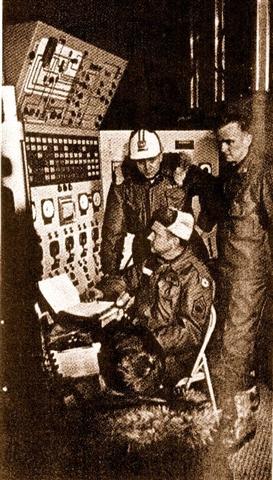
PM-2A Control Panel
In seventy-seven days, the Army team assembled the prefabricated reactor. Just nine hours after fuel elements containing forty-three pounds of enriched Uranium-235 were inserted into the reactor, electricity was produced. It was soon discovered that additional shielding would be necessary. This shielding was accomplished by adding a layer of two inch thick lead bricks to the primary shield tank. Except for downtime for routine maintenance and repairs, the reactor operated for thirty-three months, until July 9, 1963, when it was deactivated pending a decision to remove it. This decision stemmed from plans to discontinue year-round operations at Camp Century to reduce costs. In addition, the tunnel support structure sheltering the reactor was suffering from reoccurring damage due to compacting snow. A conventional diesel powered plant would have consumed over one million gallons of fuel over the same period.
While the power plant was designed to provide 1560 kilowatts of power, Camp Century's power needs peaked at 500 kilowatts, and gradually declined from there. During the reactors operational life, a total of 47,078 gallons of radioactive liquid waste was discharged into the icecap. The PM-2A was removed in the summer of 1964 by the 46th Engineers based at Fort Polk, Louisiana. No military service was willing to accept the plant at another location so the PM-2A's components were put into storage. The reactor vessel was subjected to destructive testing in order to study neutron embrittlement of carbon steel. Phillips Petroleum Company conducted the testing for the US Atomic Energy Commission in 1966. After extreme testing, it was found to be much more durable than expected. Failure of the vessel finally occurred at minus twenty degrees Fahrenheit and 4,475 pounds per square inch pressure after hydrochloric acid was added to a machined defect.
The inability of the Army to resite the Camp Century power plant foreshadowed the end of the Army's Nuclear Power Program.

BOY SCOUTS AT CAMP CENTURY
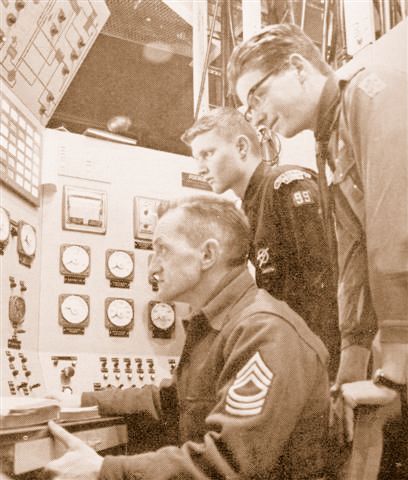
Boy Scouts Kent Goering and Soren
Gregersen look over the control panel of the
PM-2A Nuclear ReactorOn August 30, 1960, two Boy Scouts were selected to serve as "Junior Scientific Aides" at Camp Century, upon invitation of the Army Engineers. Their job was to assist the engineers and scientists at Camp Century. The two chosen were Kent Goering, of Neodesha, Kansas and Soren Gregersen of Korsor, Denmark. Goering and Gregersen were selected from the many top Scouts who applied. Beginning in October of 1960, they spent five months living and working in the city under the ice. Goering stressed that the principal lesson he learned was "how to live with others and myself, in isolation, at close quarters, every minute of every day for months." Gregersen, who spent two consecutive summers at Camp Century, described his time there as a great personal experience, and one that most likely influenced his career choice of geophysics.
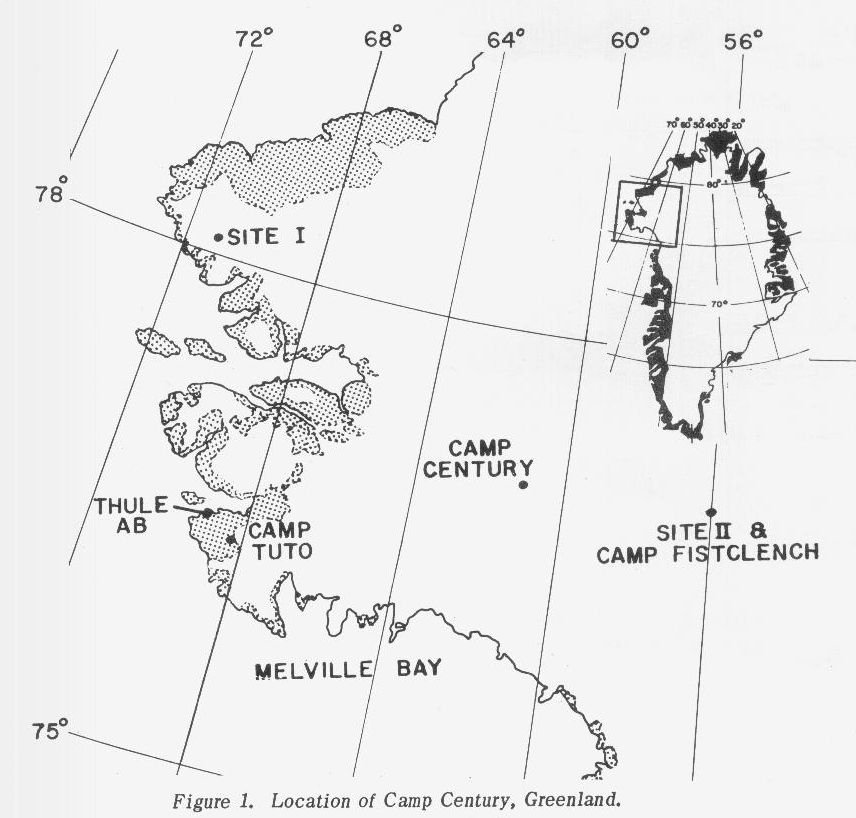
Camp Century Map
FEEDBACK MAP
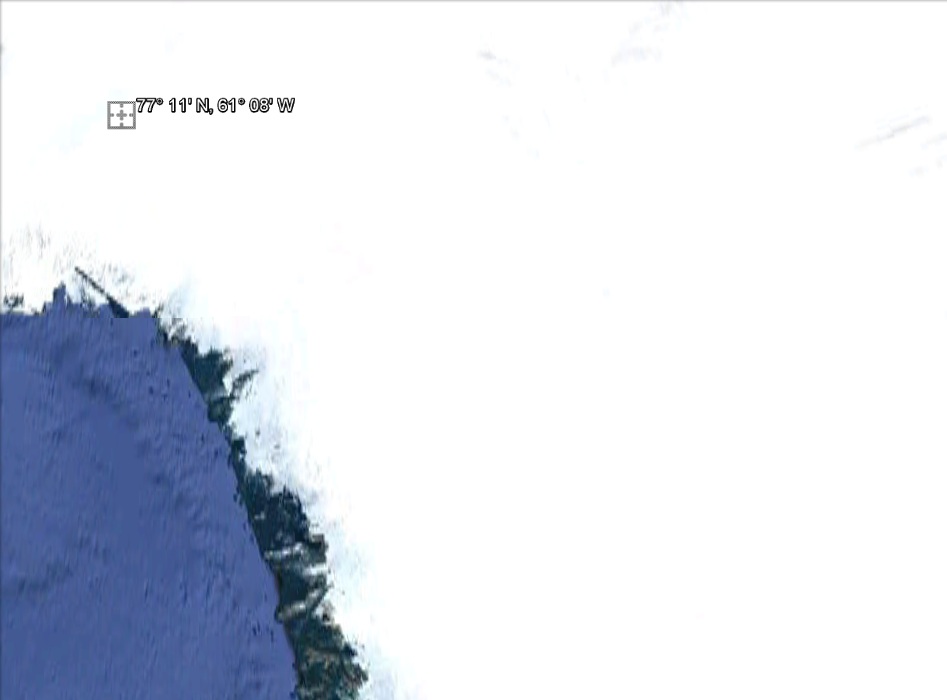
If you got impressions for which this feedback is insufficient, please take a look at the following web sites for more:
YouTube
Many thanks to Ray McClure for providing and programming this target.